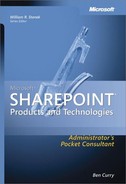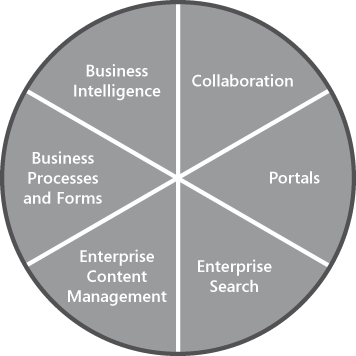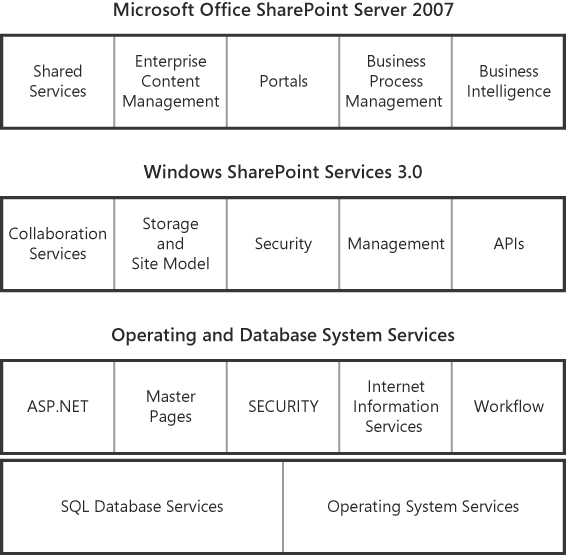In this chapter:
SharePoint Products and Your Hardware 5
Microsoft Windows SharePoint Services 3.0 and Microsoft Office SharePoint Server 2007 begin a new age in content aggregation, business process management, business intelligence, enterprise collaboration, and the content management lifecycle, as shown in Figure 1-1.
Those familiar with the previous versions of Windows SharePoint Services and Share-Point Portal Server will be pleasantly surprised with the complete rework of the product functionality and its robust ability to scale to any organizational requirement. The administration user interface (UI) has been completely redesigned to make it easier and quicker to navigate and perform administrative tasks. To understand the role that each of these products plays in the overall SharePoint Technologies suite, descriptions of Windows SharePoint Services and SharePoint Server follow.
Windows SharePoint Services Provides the core functionality for SharePoint technologies, including storage, security, search, management, deployment, site model, application programming interfaces (APIs), and collaboration. A muchappreciated improvement in Windows SharePoint Services is the addition of a common Central Administration Web interface that expands as products are installed onto the platform. Windows SharePoint Services requires Windows Server 2003 SP1 or later, Microsoft SQL Server 2000 Service Pack 3a or Microsoft SQL Server 2005, or Microsoft SQL Server Express 2005.
Microsoft Office SharePoint Server 2007 Delivers further functionality beyond what is provided with Windows SharePoint Services, including InfoPath forms services, expanded search and indexing capabilities, Business Data Catalog (BDC) to connect line-of-business (LOB) products, business intelligence, user profiles, records management, Web content management, and more. In addition, SharePoint Server provides rich Shared Services Providers and the ability to scale using IntraFarm or Inter Farm Shared Services. Figure 1-2 shows the logical architecture when implementing the entire product suite.
Although Windows Server 2003 and SQL Server are required components for any Windows SharePoint Services or SharePoint Server implementation, they are not covered in great detail here except where a specific configuration for Windows SharePoint Services is required. There are many resources detailing the installation and configuration of both products, most notably the Administrator's Companions and Administrator's Pocket Consultants series from Microsoft Press.
When choosing hardware for installing your SharePoint product, it is wise to start with at least the minimum hardware required for that product. The SharePoint Server products have many new features, which require an investment in hardware to realize their full potential. With the majority of new servers being 64-bit systems, the SharePoint product team has made it possible to include 32-bit and 64-bit systems in the same farm. This design allows organizations to tailor their usage of new and existing hardware to meet their individual needs.
The following guidelines should be considered the bare necessity when installing Windows SharePoint Services. These guidelines are not sufficient for heavily used or highly customized SharePoint installations.
Implementing a different application pool and username for each Web application strengthens your overall security stance, but every additional application pool requires more memory. Every Web application consumes 150 to 200 MB of memory in addition to the already existing application pools. As a general rule, 2 gigabytes (GB) of RAM is recommended for serving any SharePoint technology beyond a test environment. Installations requiring more than 2 GB of RAM benefit from the more efficient memory management of a 64-bit server platform. Individual service memory requirements, like those of Excel Calculation Services, are presented in their corresponding chapters. The following list details the memory requirements for each server role:
Windows SharePoint Services single box installation The minimum memory capacity for a single box installation is 1 GB of RAM, with 3 GB being recommended. A single farm box installation must be able to support all components of a SharePoint farm, including SQL Server Express 2005. If your databases will grow quite large, you should begin with 3 GB or consider using a dedicated SQL Server for database storage.
Windows SharePoint Services farm deployment When Windows SharePoint Services is deployed across multiple servers, the maximum overhead is likely reduced because the workload is distributed. That being the case, the minimum capacity is 1 GB, but the recommended is at least 2 GB. Refer to performance monitoring information in Chapter 15 to find out when to add RAM.
Office SharePoint Server single box installation The minimum memory capacity is 1 GB, but this amount is likely to be insufficient if any of the SharePoint Server added services are enabled. If using Document Conversions or Excel Calculation Services, 2 GB is the minimum memory capacity, with 3 GB being recommended. Remember that large application servers, like Search or Excel Calculation Services, require a significant amount of dedicated resources. Refer to their individual chapters for hardware requirements. A single box SharePoint Server installation is primarily for workgroup or lab environments and is not sufficient for full-scale production deployments.
Office SharePoint Server farm deployment Despite the more efficient load distribution of a SharePoint Server farm environment, an absolute minimum of 2 GB of RAM is recommended to accommodate enterprise-class applications. Most enterprise-scale installations require a minimum of 3 GB of RAM for all application- tier servers.
SQL Server 2000 SP3a or SQL Server 2005 The minimum memory requirement for a SQL Server when supporting SharePoint Server farms is 2 GB of RAM. Depending on your specific scenario, you may require more memory. For example, more than 2 GB is required when using fail-over farms for high availability or when several databases exceed 200 GB in size. It should also be noted that SQL Server 2005 will show markedly increased performance over SQL Server 2000, even when installed on equivalent hardware.
More information on configuring hardware for SQL Server can be found at http://www.microsoft.com/technet/prodtechnol/sql/default.mspx.
Although the installation of SharePoint products with slower CPUs than recommended will successfully complete, the outcome may be less than desired. When installing in test or development environments, you may install with legacy hardware and have adequate performance. However, be forewarned that Windows SharePoint Services developers may require higher CPU speeds than found in your production environment because of the heavy demands needed when developing custom code. Consult with your developers before deciding which hardware to use.
Windows SharePoint Services and SharePoint Server single box deployments When installing Windows SharePoint Services or SharePoint Server on a single box, a single 2.5-GHz processor is the absolute minimum. If your needs go beyond collaboration, creating Web pages, or another basic functionality, then you should give serious consideration to dual processors of 2.5 GHz or more.
Windows SharePoint Services and SharePoint Server Web front-end server (WFE) In many implementations it is necessary to split the processing duty among multiple tiers. When this situation arises, a single processor of 2.5 GHz for a WFE is the minimum and is often enough, unless you also have an application service, such as Excel Calculation Services (ECS), or process thousands of search queries as well. Chapter 13 covers in detail the scaling of WFEs.
Windows SharePoint Services and SharePoint Server application servers The new versions of both products allow for unrestricted scaling to almost any requirement. Application servers, such as Excel Calculation Services (ECS), Indexing, Query, and InfoPath forms services, can be very processor intensive. For this reason, dual 2-GHz processors are the recommended minimum CPU for dedicated application servers. Windows SharePoint Services and SharePoint Server use symmetric multiprocessing, which enables greatly increased performance of application-tier services. In addition, 64-bit hardware can noticeably improve the performance of Indexing and Excel Calculation Services.
SQL Server 2000 SP3a or SQL Server 2005 You should consider upgrading your current SQL Server environment to 64-bit hardware if you have not already. The bottleneck of many busy Windows SharePoint Services and SharePoint Server installations is the SQL Server installation. Medium scale and larger implementations should consider a minimum of dual 2.5-GHz processors or data processing delays could occur.
The many storage options available include integrated drive electronics (IDE), small computer system interface (SCSI), Fibre Channel, and Low-Cost Fibre Channel (LCFC). Serial Advanced Technology Attachment (SATA) drives should be considered the minimum for any serious implementation, with Fibre Channel providing the highest level of performance and longevity. A full discussion of storage technologies is beyond the scope of this book, but be aware that many organizations now use storage area networks (SANs) to facilitate provisioning and disaster recovery. Modern SANs can include SATA, LCFC, or Fibre Channel drives and enable error checking on the storage frame, instead of on the server system itself. Check with your SAN administrator for more information.
For information on data protection using technologies such as RAID (redundant array of independent disks), consult the Windows Server TechCenter at http://www.microsoft.com/technet/windowsserver/default.mspx.


